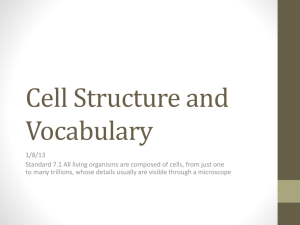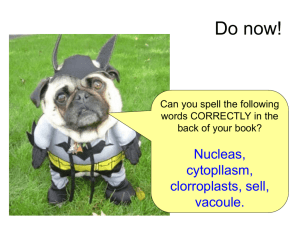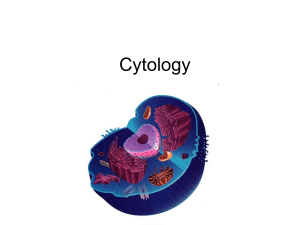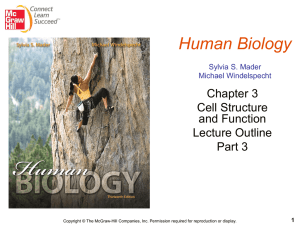The Endomembrane System
advertisement
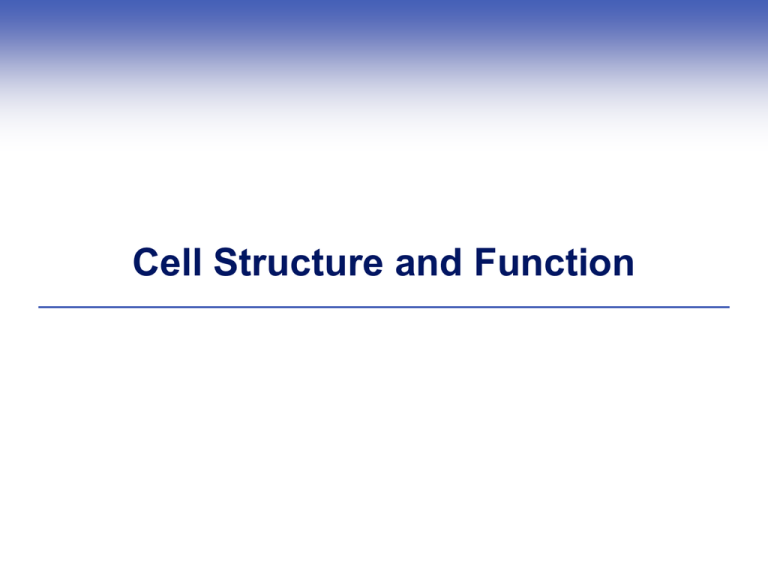
Cell Structure and Function What is a Cell? Each cell has a plasma membrane, cytoplasm, and a nucleus (in eukaryotic cells) or a nucleoid (in prokaryotic cells) Components of Cell Membranes Lipid bilayer Cell Size and Shape Surface-to-volume ratio limits cell size Key Concepts: WHAT ALL CELLS HAVE IN COMMON Each cell has a plasma membrane, a boundary between its interior and the outside environment The interior consists of cytoplasm and an innermost region of DNA How Do We See Cells? Three key points of the cell theory: • All organisms consist of one or more cells • The cell is the smallest unit that retains the capacity for life • A cell arises from the growth and division of another cell Relative Sizes Membrane Structure and Function Each cell membrane is a boundary (lipid bilayer) that controls the flow of substances across it Fluid mosaic model • Membrane is composed of phospholipids, cholesterol, proteins, and other components • Phospholipids drift within the bilayer Common Membrane Proteins Introducing Prokaryotic Cells Bacteria and archaeans • The simplest cells • The groups with greatest metabolic diversity Prokaryote Structure Cell wall • Surrounds plasma membrane Flagella • Used for motion Pili • Protein filaments used for attachment • “Sex” pilus transfers genetic material cytoplasm, with ribosomes bacterial flagellum Most prokaryotic cells have a cell wall outside the plasma membrane, and many have a thick, jellylike capsule around the wall. DNA in cell plasma pilus capsule wall membrane nucleoid Introducing Eukaryotic Cells Start with a nucleus and other organelles • Carry out specialized functions inside a cell Components of The Nucleus Nucleus separates DNA from cytoplasm • Chromatin (all chromosomal DNA with proteins) • Chromosomes (condensed) Nucleolus assembles ribosome subunits Nuclear envelope and Pores Nucleus and Nuclear Envelope Nucleus and Nuclear Envelope Nucleus and Nuclear Envelope The Endomembrane System Endoplasmic reticulum (ER) • An extension of the nuclear envelope • RER modifies new polypeptide chains • SER makes lipids; other metabolic functions Golgi bodies • Further modify polypeptides • Assemble lipids The Endomembrane System Vesicles • Endocytic and exocytic: Transport or store polypeptides and lipids • Peroxisomes: Digest fatty acids and amino acids; break down toxins and metabolic by-products • Lysosomes: Intracellular digestion (animals) • Central vacuole: Storage; fluid pressure (plants) Endomembrane System Endomembrane System Endomembrane System Mitochondria and Chloroplasts Mitochondria • Break down organic compounds by aerobic respiration (oxygen-requiring) • Produce ATP Chloroplasts • Produce sugars by photosynthesis Mitochondria and Chloroplasts The Dynamic Cytoskeleton Components of the cytoskeleton • Microtubules • Microfilaments • Intermediate filaments Components of the Cytoskeleton Cytoskeleton Function Organizes and moves cell parts Reinforces cell shape Interactions between motor proteins and microtubules in cilia, flagella, and pseudopods can move the whole cell Flagellum and Pseudopods




